Report: Crowdfunding Advice for a Battery Life Extension Venture
VerifiedAdded on 2020/03/04
|12
|2964
|75
Report
AI Summary
This report provides comprehensive advice on crowdfunding, specifically tailored for a new venture aiming to extend battery life. It begins by defining crowdfunding and highlighting its advantages for entrepreneurs, including its role in market validation and capital raising. The report then delves into the four main types of crowdfunding: reward-based, donation-based, equity-based, and lending-based, explaining how each can be applied to the client's business. It explores the use of online platforms for crowdfunding, drawing on examples like Kickstarter and Indiegogo, and discusses successful crowdfunding campaigns in various sectors, including gaming and civic projects. The report analyzes the legislative framework for crowdfunding in Australia, including the Corporations Amendment (Crowd-sourced Funding) Act 2017 and related regulations, emphasizing the reduced regulatory requirements and investor protection measures. It also references international examples, such as New Zealand's comprehensive CSEF regime. The report concludes by emphasizing the potential of crowdfunding as a viable funding source for the client's innovation, offering insights into navigating the crowdfunding landscape and complying with relevant regulations.
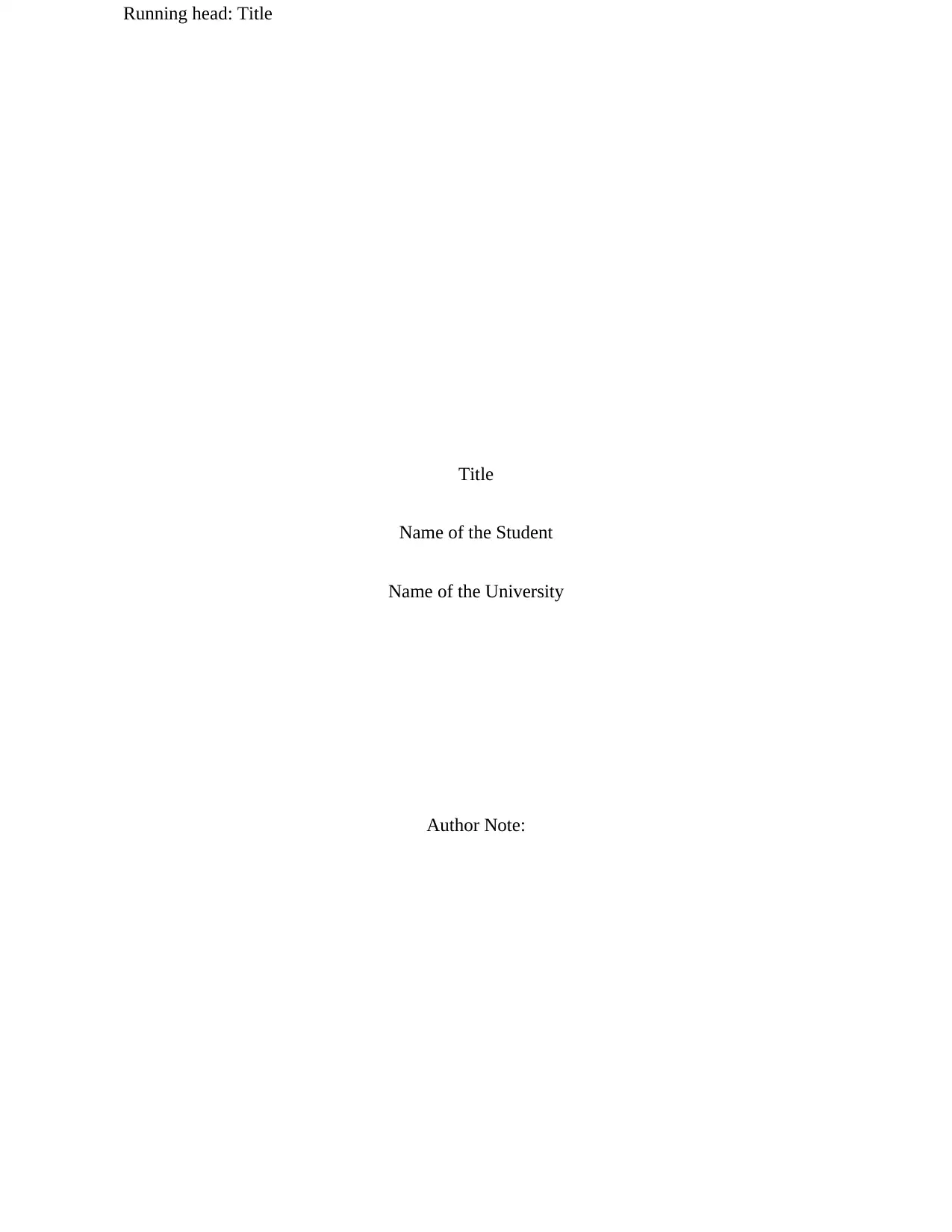
Running head: Title
Title
Name of the Student
Name of the University
Author Note:
Title
Name of the Student
Name of the University
Author Note:
Paraphrase This Document
Need a fresh take? Get an instant paraphrase of this document with our AI Paraphraser
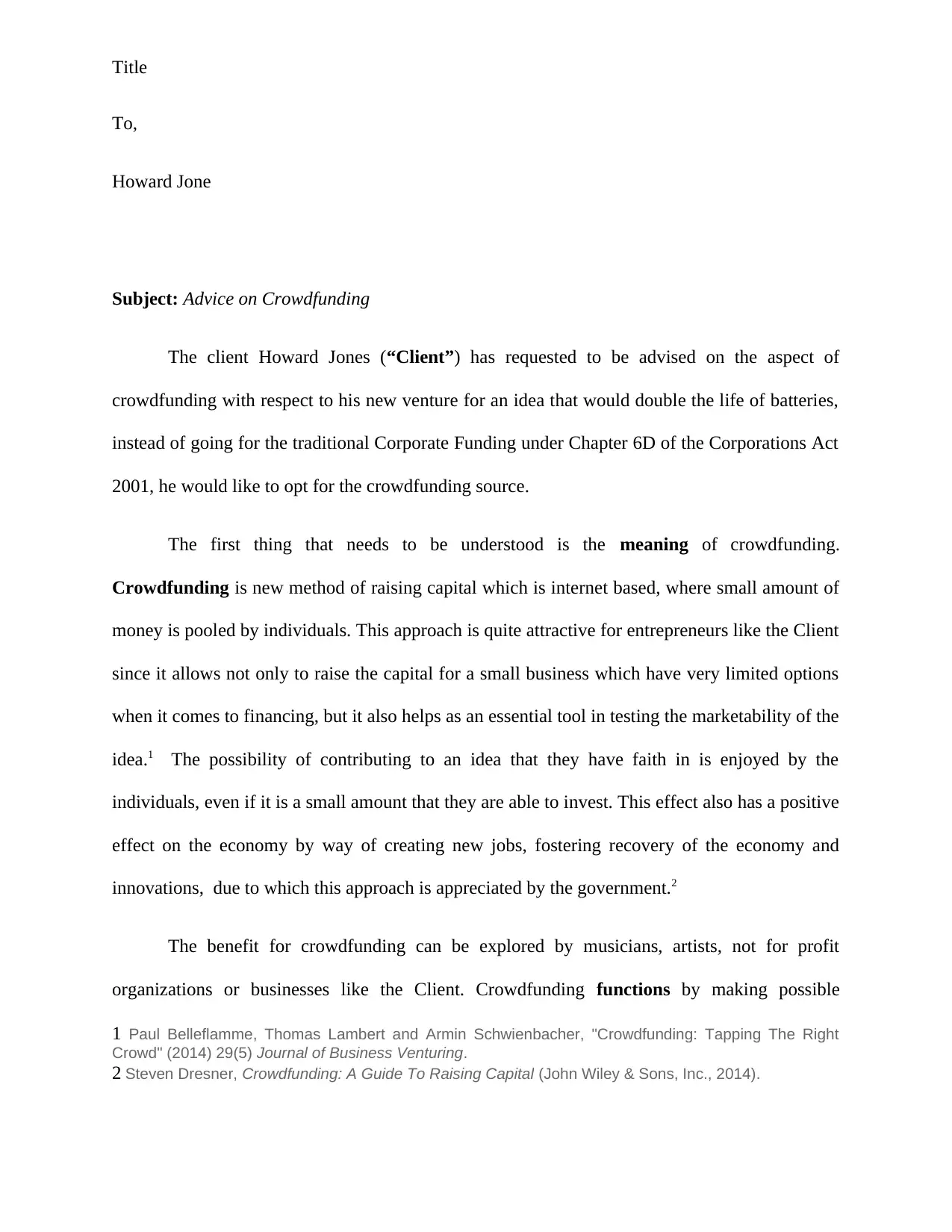
Title
To,
Howard Jone
Subject: Advice on Crowdfunding
The client Howard Jones (“Client”) has requested to be advised on the aspect of
crowdfunding with respect to his new venture for an idea that would double the life of batteries,
instead of going for the traditional Corporate Funding under Chapter 6D of the Corporations Act
2001, he would like to opt for the crowdfunding source.
The first thing that needs to be understood is the meaning of crowdfunding.
Crowdfunding is new method of raising capital which is internet based, where small amount of
money is pooled by individuals. This approach is quite attractive for entrepreneurs like the Client
since it allows not only to raise the capital for a small business which have very limited options
when it comes to financing, but it also helps as an essential tool in testing the marketability of the
idea.1 The possibility of contributing to an idea that they have faith in is enjoyed by the
individuals, even if it is a small amount that they are able to invest. This effect also has a positive
effect on the economy by way of creating new jobs, fostering recovery of the economy and
innovations, due to which this approach is appreciated by the government.2
The benefit for crowdfunding can be explored by musicians, artists, not for profit
organizations or businesses like the Client. Crowdfunding functions by making possible
1 Paul Belleflamme, Thomas Lambert and Armin Schwienbacher, "Crowdfunding: Tapping The Right
Crowd" (2014) 29(5) Journal of Business Venturing.
2 Steven Dresner, Crowdfunding: A Guide To Raising Capital (John Wiley & Sons, Inc., 2014).
To,
Howard Jone
Subject: Advice on Crowdfunding
The client Howard Jones (“Client”) has requested to be advised on the aspect of
crowdfunding with respect to his new venture for an idea that would double the life of batteries,
instead of going for the traditional Corporate Funding under Chapter 6D of the Corporations Act
2001, he would like to opt for the crowdfunding source.
The first thing that needs to be understood is the meaning of crowdfunding.
Crowdfunding is new method of raising capital which is internet based, where small amount of
money is pooled by individuals. This approach is quite attractive for entrepreneurs like the Client
since it allows not only to raise the capital for a small business which have very limited options
when it comes to financing, but it also helps as an essential tool in testing the marketability of the
idea.1 The possibility of contributing to an idea that they have faith in is enjoyed by the
individuals, even if it is a small amount that they are able to invest. This effect also has a positive
effect on the economy by way of creating new jobs, fostering recovery of the economy and
innovations, due to which this approach is appreciated by the government.2
The benefit for crowdfunding can be explored by musicians, artists, not for profit
organizations or businesses like the Client. Crowdfunding functions by making possible
1 Paul Belleflamme, Thomas Lambert and Armin Schwienbacher, "Crowdfunding: Tapping The Right
Crowd" (2014) 29(5) Journal of Business Venturing.
2 Steven Dresner, Crowdfunding: A Guide To Raising Capital (John Wiley & Sons, Inc., 2014).
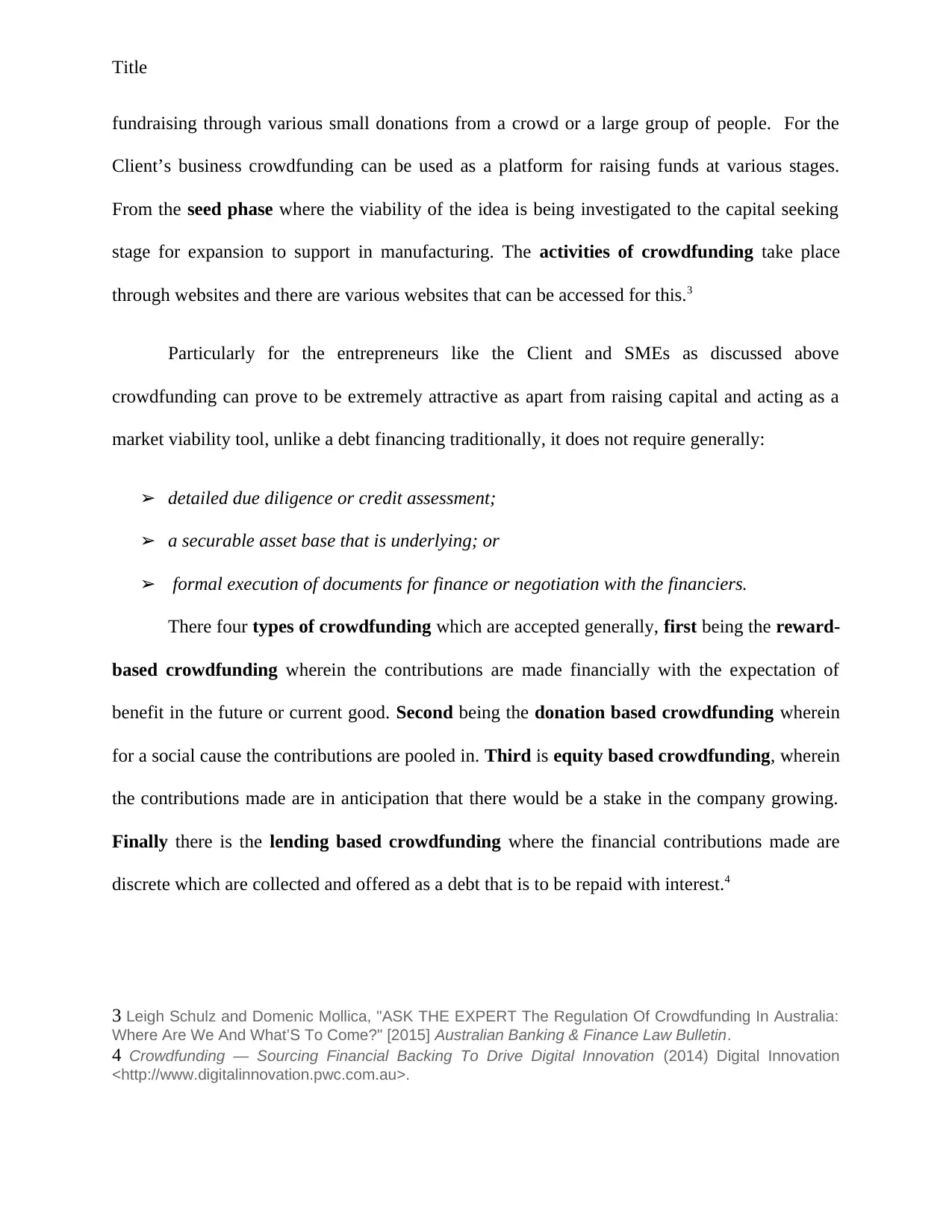
Title
fundraising through various small donations from a crowd or a large group of people. For the
Client’s business crowdfunding can be used as a platform for raising funds at various stages.
From the seed phase where the viability of the idea is being investigated to the capital seeking
stage for expansion to support in manufacturing. The activities of crowdfunding take place
through websites and there are various websites that can be accessed for this.3
Particularly for the entrepreneurs like the Client and SMEs as discussed above
crowdfunding can prove to be extremely attractive as apart from raising capital and acting as a
market viability tool, unlike a debt financing traditionally, it does not require generally:
➢ detailed due diligence or credit assessment;
➢ a securable asset base that is underlying; or
➢ formal execution of documents for finance or negotiation with the financiers.
There four types of crowdfunding which are accepted generally, first being the reward-
based crowdfunding wherein the contributions are made financially with the expectation of
benefit in the future or current good. Second being the donation based crowdfunding wherein
for a social cause the contributions are pooled in. Third is equity based crowdfunding, wherein
the contributions made are in anticipation that there would be a stake in the company growing.
Finally there is the lending based crowdfunding where the financial contributions made are
discrete which are collected and offered as a debt that is to be repaid with interest.4
3 Leigh Schulz and Domenic Mollica, "ASK THE EXPERT The Regulation Of Crowdfunding In Australia:
Where Are We And What’S To Come?" [2015] Australian Banking & Finance Law Bulletin.
4 Crowdfunding — Sourcing Financial Backing To Drive Digital Innovation (2014) Digital Innovation
<http://www.digitalinnovation.pwc.com.au>.
fundraising through various small donations from a crowd or a large group of people. For the
Client’s business crowdfunding can be used as a platform for raising funds at various stages.
From the seed phase where the viability of the idea is being investigated to the capital seeking
stage for expansion to support in manufacturing. The activities of crowdfunding take place
through websites and there are various websites that can be accessed for this.3
Particularly for the entrepreneurs like the Client and SMEs as discussed above
crowdfunding can prove to be extremely attractive as apart from raising capital and acting as a
market viability tool, unlike a debt financing traditionally, it does not require generally:
➢ detailed due diligence or credit assessment;
➢ a securable asset base that is underlying; or
➢ formal execution of documents for finance or negotiation with the financiers.
There four types of crowdfunding which are accepted generally, first being the reward-
based crowdfunding wherein the contributions are made financially with the expectation of
benefit in the future or current good. Second being the donation based crowdfunding wherein
for a social cause the contributions are pooled in. Third is equity based crowdfunding, wherein
the contributions made are in anticipation that there would be a stake in the company growing.
Finally there is the lending based crowdfunding where the financial contributions made are
discrete which are collected and offered as a debt that is to be repaid with interest.4
3 Leigh Schulz and Domenic Mollica, "ASK THE EXPERT The Regulation Of Crowdfunding In Australia:
Where Are We And What’S To Come?" [2015] Australian Banking & Finance Law Bulletin.
4 Crowdfunding — Sourcing Financial Backing To Drive Digital Innovation (2014) Digital Innovation
<http://www.digitalinnovation.pwc.com.au>.
⊘ This is a preview!⊘
Do you want full access?
Subscribe today to unlock all pages.

Trusted by 1+ million students worldwide
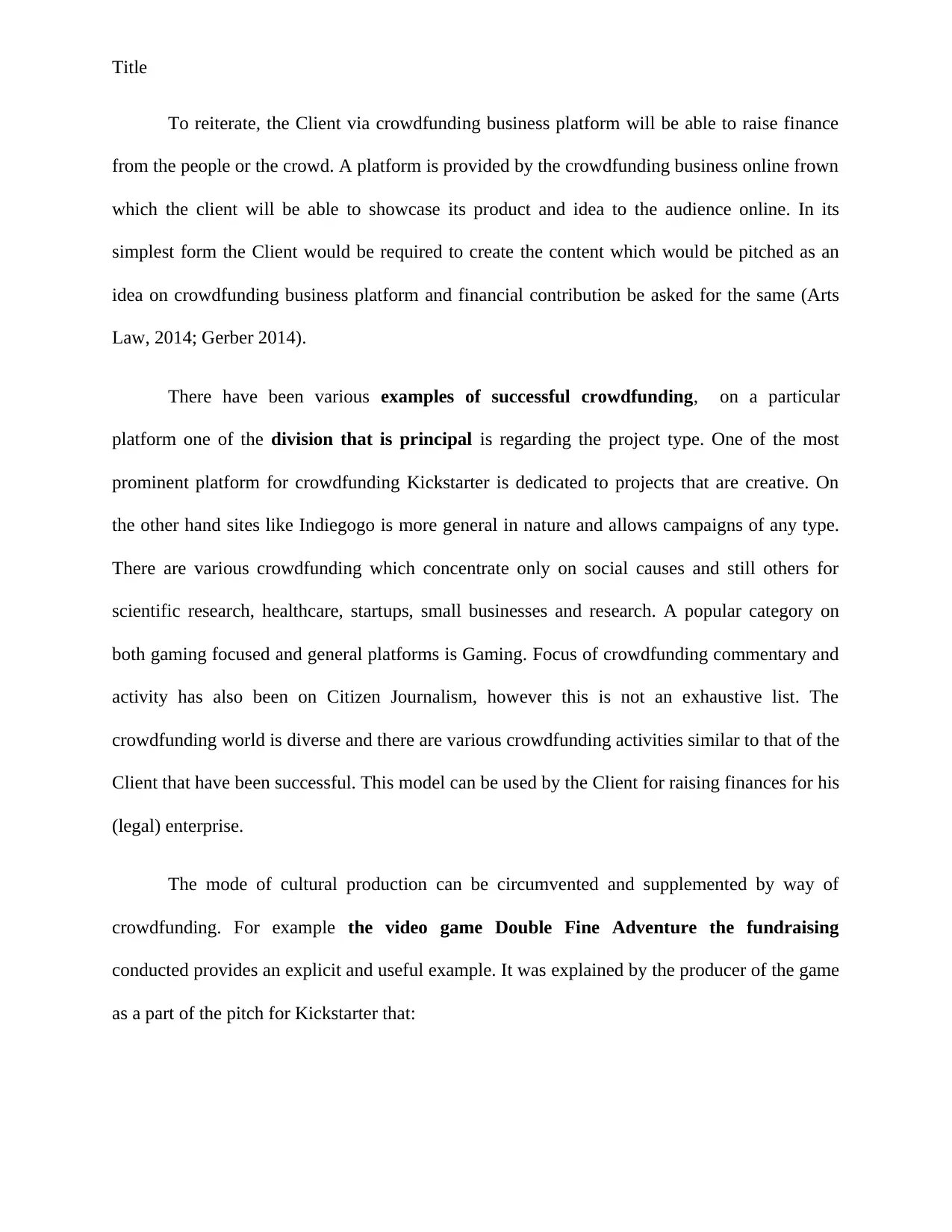
Title
To reiterate, the Client via crowdfunding business platform will be able to raise finance
from the people or the crowd. A platform is provided by the crowdfunding business online frown
which the client will be able to showcase its product and idea to the audience online. In its
simplest form the Client would be required to create the content which would be pitched as an
idea on crowdfunding business platform and financial contribution be asked for the same (Arts
Law, 2014; Gerber 2014).
There have been various examples of successful crowdfunding, on a particular
platform one of the division that is principal is regarding the project type. One of the most
prominent platform for crowdfunding Kickstarter is dedicated to projects that are creative. On
the other hand sites like Indiegogo is more general in nature and allows campaigns of any type.
There are various crowdfunding which concentrate only on social causes and still others for
scientific research, healthcare, startups, small businesses and research. A popular category on
both gaming focused and general platforms is Gaming. Focus of crowdfunding commentary and
activity has also been on Citizen Journalism, however this is not an exhaustive list. The
crowdfunding world is diverse and there are various crowdfunding activities similar to that of the
Client that have been successful. This model can be used by the Client for raising finances for his
(legal) enterprise.
The mode of cultural production can be circumvented and supplemented by way of
crowdfunding. For example the video game Double Fine Adventure the fundraising
conducted provides an explicit and useful example. It was explained by the producer of the game
as a part of the pitch for Kickstarter that:
To reiterate, the Client via crowdfunding business platform will be able to raise finance
from the people or the crowd. A platform is provided by the crowdfunding business online frown
which the client will be able to showcase its product and idea to the audience online. In its
simplest form the Client would be required to create the content which would be pitched as an
idea on crowdfunding business platform and financial contribution be asked for the same (Arts
Law, 2014; Gerber 2014).
There have been various examples of successful crowdfunding, on a particular
platform one of the division that is principal is regarding the project type. One of the most
prominent platform for crowdfunding Kickstarter is dedicated to projects that are creative. On
the other hand sites like Indiegogo is more general in nature and allows campaigns of any type.
There are various crowdfunding which concentrate only on social causes and still others for
scientific research, healthcare, startups, small businesses and research. A popular category on
both gaming focused and general platforms is Gaming. Focus of crowdfunding commentary and
activity has also been on Citizen Journalism, however this is not an exhaustive list. The
crowdfunding world is diverse and there are various crowdfunding activities similar to that of the
Client that have been successful. This model can be used by the Client for raising finances for his
(legal) enterprise.
The mode of cultural production can be circumvented and supplemented by way of
crowdfunding. For example the video game Double Fine Adventure the fundraising
conducted provides an explicit and useful example. It was explained by the producer of the game
as a part of the pitch for Kickstarter that:
Paraphrase This Document
Need a fresh take? Get an instant paraphrase of this document with our AI Paraphraser
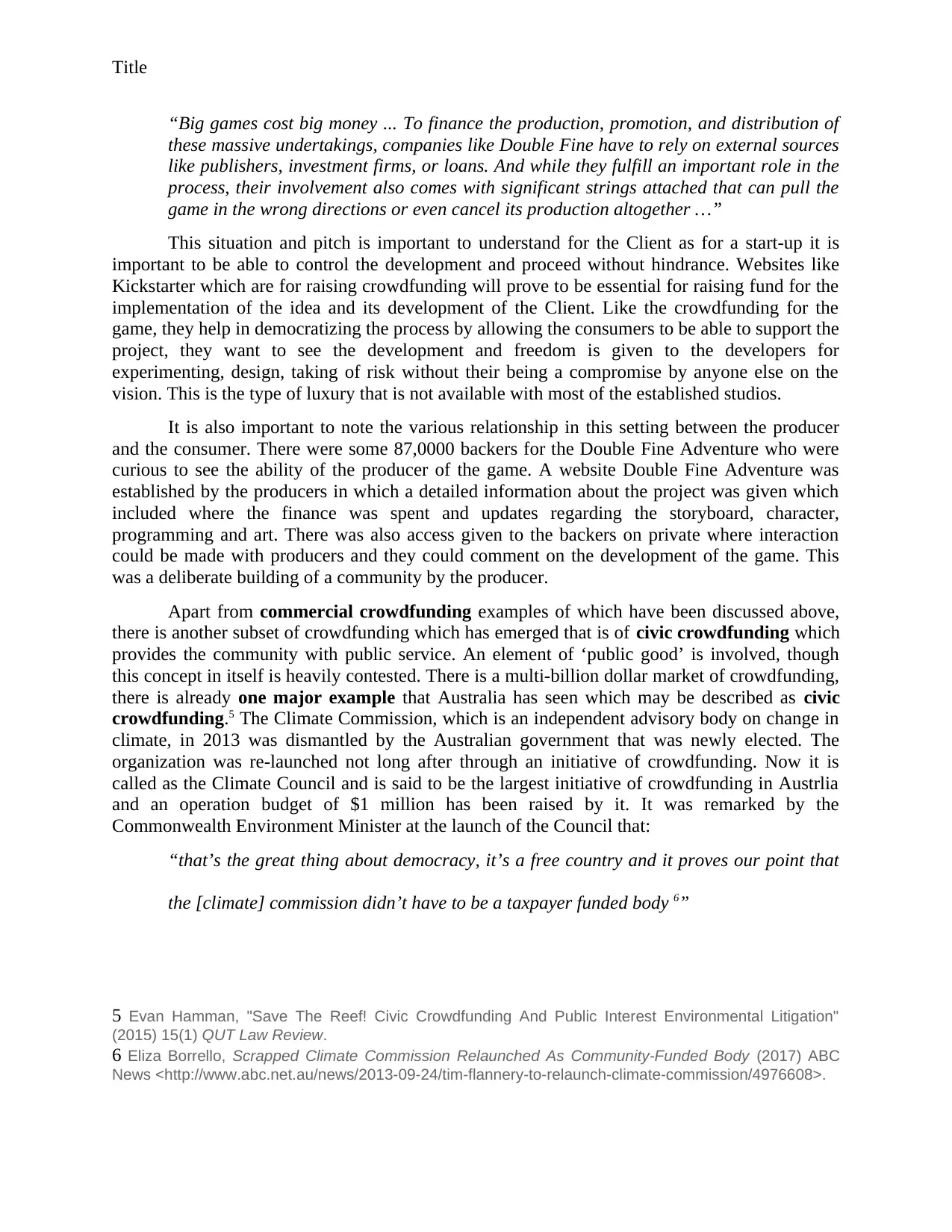
Title
“Big games cost big money ... To finance the production, promotion, and distribution of
these massive undertakings, companies like Double Fine have to rely on external sources
like publishers, investment firms, or loans. And while they fulfill an important role in the
process, their involvement also comes with significant strings attached that can pull the
game in the wrong directions or even cancel its production altogether …”
This situation and pitch is important to understand for the Client as for a start-up it is
important to be able to control the development and proceed without hindrance. Websites like
Kickstarter which are for raising crowdfunding will prove to be essential for raising fund for the
implementation of the idea and its development of the Client. Like the crowdfunding for the
game, they help in democratizing the process by allowing the consumers to be able to support the
project, they want to see the development and freedom is given to the developers for
experimenting, design, taking of risk without their being a compromise by anyone else on the
vision. This is the type of luxury that is not available with most of the established studios.
It is also important to note the various relationship in this setting between the producer
and the consumer. There were some 87,0000 backers for the Double Fine Adventure who were
curious to see the ability of the producer of the game. A website Double Fine Adventure was
established by the producers in which a detailed information about the project was given which
included where the finance was spent and updates regarding the storyboard, character,
programming and art. There was also access given to the backers on private where interaction
could be made with producers and they could comment on the development of the game. This
was a deliberate building of a community by the producer.
Apart from commercial crowdfunding examples of which have been discussed above,
there is another subset of crowdfunding which has emerged that is of civic crowdfunding which
provides the community with public service. An element of ‘public good’ is involved, though
this concept in itself is heavily contested. There is a multi-billion dollar market of crowdfunding,
there is already one major example that Australia has seen which may be described as civic
crowdfunding.5 The Climate Commission, which is an independent advisory body on change in
climate, in 2013 was dismantled by the Australian government that was newly elected. The
organization was re-launched not long after through an initiative of crowdfunding. Now it is
called as the Climate Council and is said to be the largest initiative of crowdfunding in Austrlia
and an operation budget of $1 million has been raised by it. It was remarked by the
Commonwealth Environment Minister at the launch of the Council that:
“that’s the great thing about democracy, it’s a free country and it proves our point that
the [climate] commission didn’t have to be a taxpayer funded body 6”
5 Evan Hamman, "Save The Reef! Civic Crowdfunding And Public Interest Environmental Litigation"
(2015) 15(1) QUT Law Review.
6 Eliza Borrello, Scrapped Climate Commission Relaunched As Community-Funded Body (2017) ABC
News <http://www.abc.net.au/news/2013-09-24/tim-flannery-to-relaunch-climate-commission/4976608>.
“Big games cost big money ... To finance the production, promotion, and distribution of
these massive undertakings, companies like Double Fine have to rely on external sources
like publishers, investment firms, or loans. And while they fulfill an important role in the
process, their involvement also comes with significant strings attached that can pull the
game in the wrong directions or even cancel its production altogether …”
This situation and pitch is important to understand for the Client as for a start-up it is
important to be able to control the development and proceed without hindrance. Websites like
Kickstarter which are for raising crowdfunding will prove to be essential for raising fund for the
implementation of the idea and its development of the Client. Like the crowdfunding for the
game, they help in democratizing the process by allowing the consumers to be able to support the
project, they want to see the development and freedom is given to the developers for
experimenting, design, taking of risk without their being a compromise by anyone else on the
vision. This is the type of luxury that is not available with most of the established studios.
It is also important to note the various relationship in this setting between the producer
and the consumer. There were some 87,0000 backers for the Double Fine Adventure who were
curious to see the ability of the producer of the game. A website Double Fine Adventure was
established by the producers in which a detailed information about the project was given which
included where the finance was spent and updates regarding the storyboard, character,
programming and art. There was also access given to the backers on private where interaction
could be made with producers and they could comment on the development of the game. This
was a deliberate building of a community by the producer.
Apart from commercial crowdfunding examples of which have been discussed above,
there is another subset of crowdfunding which has emerged that is of civic crowdfunding which
provides the community with public service. An element of ‘public good’ is involved, though
this concept in itself is heavily contested. There is a multi-billion dollar market of crowdfunding,
there is already one major example that Australia has seen which may be described as civic
crowdfunding.5 The Climate Commission, which is an independent advisory body on change in
climate, in 2013 was dismantled by the Australian government that was newly elected. The
organization was re-launched not long after through an initiative of crowdfunding. Now it is
called as the Climate Council and is said to be the largest initiative of crowdfunding in Austrlia
and an operation budget of $1 million has been raised by it. It was remarked by the
Commonwealth Environment Minister at the launch of the Council that:
“that’s the great thing about democracy, it’s a free country and it proves our point that
the [climate] commission didn’t have to be a taxpayer funded body 6”
5 Evan Hamman, "Save The Reef! Civic Crowdfunding And Public Interest Environmental Litigation"
(2015) 15(1) QUT Law Review.
6 Eliza Borrello, Scrapped Climate Commission Relaunched As Community-Funded Body (2017) ABC
News <http://www.abc.net.au/news/2013-09-24/tim-flannery-to-relaunch-climate-commission/4976608>.
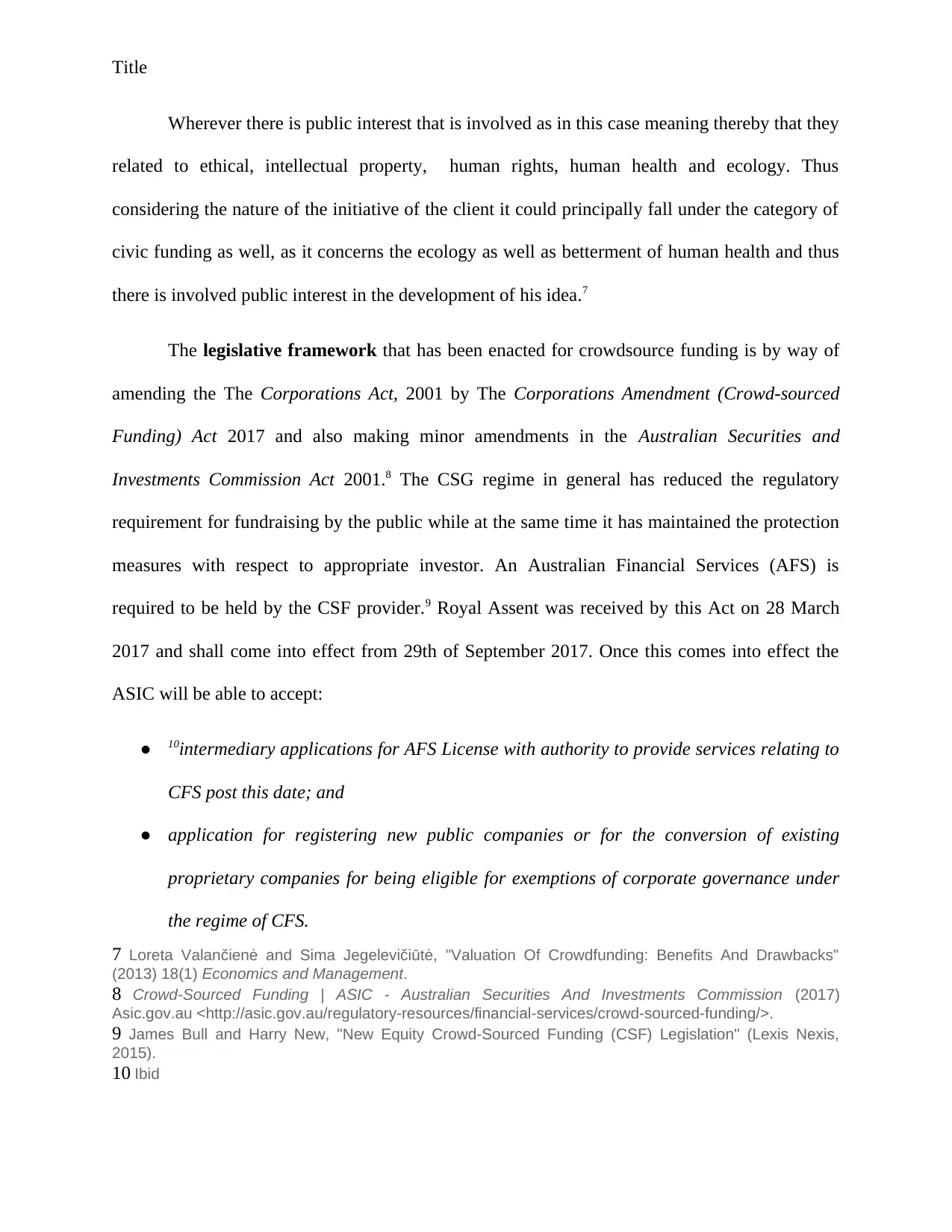
Title
Wherever there is public interest that is involved as in this case meaning thereby that they
related to ethical, intellectual property, human rights, human health and ecology. Thus
considering the nature of the initiative of the client it could principally fall under the category of
civic funding as well, as it concerns the ecology as well as betterment of human health and thus
there is involved public interest in the development of his idea.7
The legislative framework that has been enacted for crowdsource funding is by way of
amending the The Corporations Act, 2001 by The Corporations Amendment (Crowd-sourced
Funding) Act 2017 and also making minor amendments in the Australian Securities and
Investments Commission Act 2001.8 The CSG regime in general has reduced the regulatory
requirement for fundraising by the public while at the same time it has maintained the protection
measures with respect to appropriate investor. An Australian Financial Services (AFS) is
required to be held by the CSF provider.9 Royal Assent was received by this Act on 28 March
2017 and shall come into effect from 29th of September 2017. Once this comes into effect the
ASIC will be able to accept:
● 10intermediary applications for AFS License with authority to provide services relating to
CFS post this date; and
● application for registering new public companies or for the conversion of existing
proprietary companies for being eligible for exemptions of corporate governance under
the regime of CFS.
7 Loreta Valančienė and Sima Jegelevičiūtė, "Valuation Of Crowdfunding: Benefits And Drawbacks"
(2013) 18(1) Economics and Management.
8 Crowd-Sourced Funding | ASIC - Australian Securities And Investments Commission (2017)
Asic.gov.au <http://asic.gov.au/regulatory-resources/financial-services/crowd-sourced-funding/>.
9 James Bull and Harry New, "New Equity Crowd-Sourced Funding (CSF) Legislation" (Lexis Nexis,
2015).
10 Ibid
Wherever there is public interest that is involved as in this case meaning thereby that they
related to ethical, intellectual property, human rights, human health and ecology. Thus
considering the nature of the initiative of the client it could principally fall under the category of
civic funding as well, as it concerns the ecology as well as betterment of human health and thus
there is involved public interest in the development of his idea.7
The legislative framework that has been enacted for crowdsource funding is by way of
amending the The Corporations Act, 2001 by The Corporations Amendment (Crowd-sourced
Funding) Act 2017 and also making minor amendments in the Australian Securities and
Investments Commission Act 2001.8 The CSG regime in general has reduced the regulatory
requirement for fundraising by the public while at the same time it has maintained the protection
measures with respect to appropriate investor. An Australian Financial Services (AFS) is
required to be held by the CSF provider.9 Royal Assent was received by this Act on 28 March
2017 and shall come into effect from 29th of September 2017. Once this comes into effect the
ASIC will be able to accept:
● 10intermediary applications for AFS License with authority to provide services relating to
CFS post this date; and
● application for registering new public companies or for the conversion of existing
proprietary companies for being eligible for exemptions of corporate governance under
the regime of CFS.
7 Loreta Valančienė and Sima Jegelevičiūtė, "Valuation Of Crowdfunding: Benefits And Drawbacks"
(2013) 18(1) Economics and Management.
8 Crowd-Sourced Funding | ASIC - Australian Securities And Investments Commission (2017)
Asic.gov.au <http://asic.gov.au/regulatory-resources/financial-services/crowd-sourced-funding/>.
9 James Bull and Harry New, "New Equity Crowd-Sourced Funding (CSF) Legislation" (Lexis Nexis,
2015).
10 Ibid
⊘ This is a preview!⊘
Do you want full access?
Subscribe today to unlock all pages.

Trusted by 1+ million students worldwide
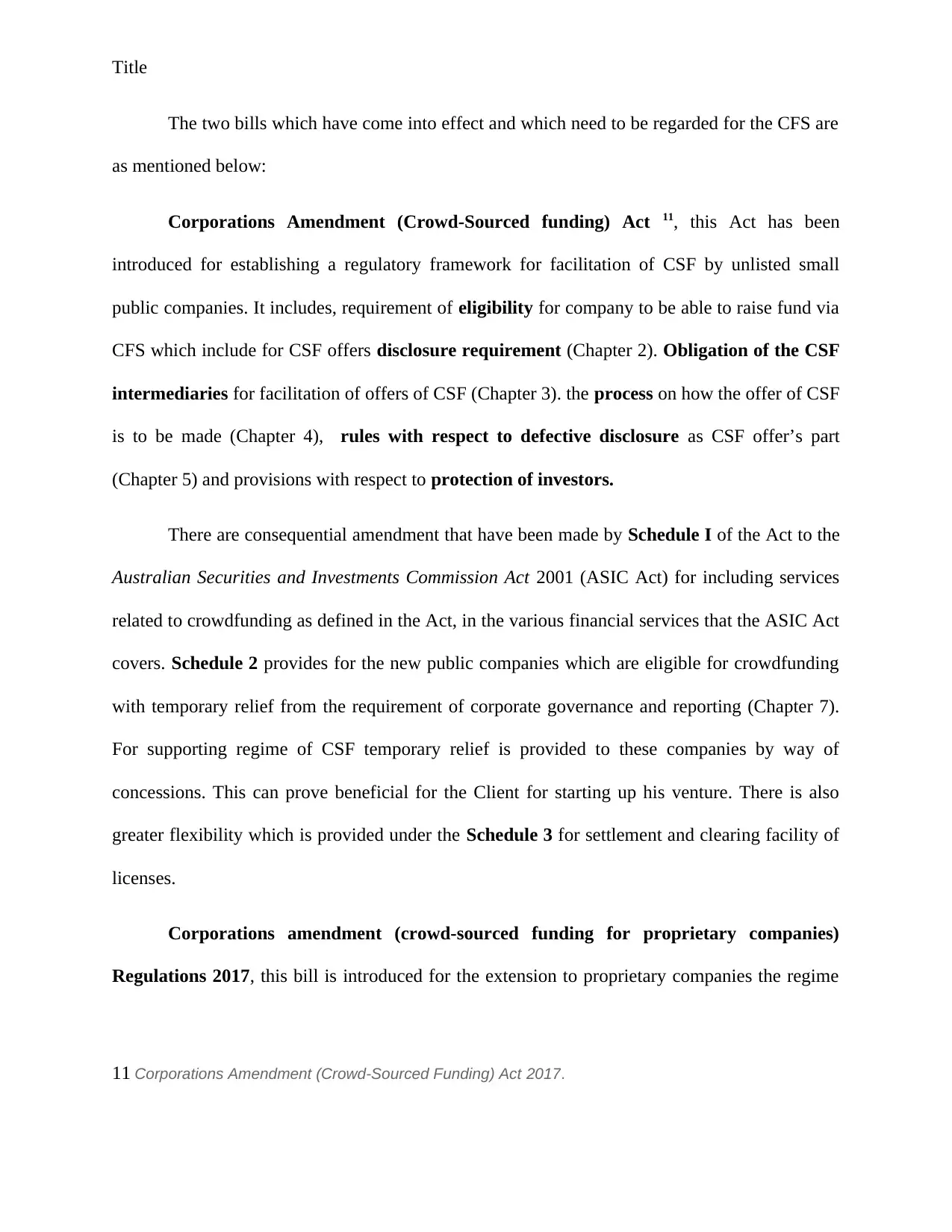
Title
The two bills which have come into effect and which need to be regarded for the CFS are
as mentioned below:
Corporations Amendment (Crowd-Sourced funding) Act 11, this Act has been
introduced for establishing a regulatory framework for facilitation of CSF by unlisted small
public companies. It includes, requirement of eligibility for company to be able to raise fund via
CFS which include for CSF offers disclosure requirement (Chapter 2). Obligation of the CSF
intermediaries for facilitation of offers of CSF (Chapter 3). the process on how the offer of CSF
is to be made (Chapter 4), rules with respect to defective disclosure as CSF offer’s part
(Chapter 5) and provisions with respect to protection of investors.
There are consequential amendment that have been made by Schedule I of the Act to the
Australian Securities and Investments Commission Act 2001 (ASIC Act) for including services
related to crowdfunding as defined in the Act, in the various financial services that the ASIC Act
covers. Schedule 2 provides for the new public companies which are eligible for crowdfunding
with temporary relief from the requirement of corporate governance and reporting (Chapter 7).
For supporting regime of CSF temporary relief is provided to these companies by way of
concessions. This can prove beneficial for the Client for starting up his venture. There is also
greater flexibility which is provided under the Schedule 3 for settlement and clearing facility of
licenses.
Corporations amendment (crowd-sourced funding for proprietary companies)
Regulations 2017, this bill is introduced for the extension to proprietary companies the regime
11 Corporations Amendment (Crowd-Sourced Funding) Act 2017.
The two bills which have come into effect and which need to be regarded for the CFS are
as mentioned below:
Corporations Amendment (Crowd-Sourced funding) Act 11, this Act has been
introduced for establishing a regulatory framework for facilitation of CSF by unlisted small
public companies. It includes, requirement of eligibility for company to be able to raise fund via
CFS which include for CSF offers disclosure requirement (Chapter 2). Obligation of the CSF
intermediaries for facilitation of offers of CSF (Chapter 3). the process on how the offer of CSF
is to be made (Chapter 4), rules with respect to defective disclosure as CSF offer’s part
(Chapter 5) and provisions with respect to protection of investors.
There are consequential amendment that have been made by Schedule I of the Act to the
Australian Securities and Investments Commission Act 2001 (ASIC Act) for including services
related to crowdfunding as defined in the Act, in the various financial services that the ASIC Act
covers. Schedule 2 provides for the new public companies which are eligible for crowdfunding
with temporary relief from the requirement of corporate governance and reporting (Chapter 7).
For supporting regime of CSF temporary relief is provided to these companies by way of
concessions. This can prove beneficial for the Client for starting up his venture. There is also
greater flexibility which is provided under the Schedule 3 for settlement and clearing facility of
licenses.
Corporations amendment (crowd-sourced funding for proprietary companies)
Regulations 2017, this bill is introduced for the extension to proprietary companies the regime
11 Corporations Amendment (Crowd-Sourced Funding) Act 2017.
Paraphrase This Document
Need a fresh take? Get an instant paraphrase of this document with our AI Paraphraser
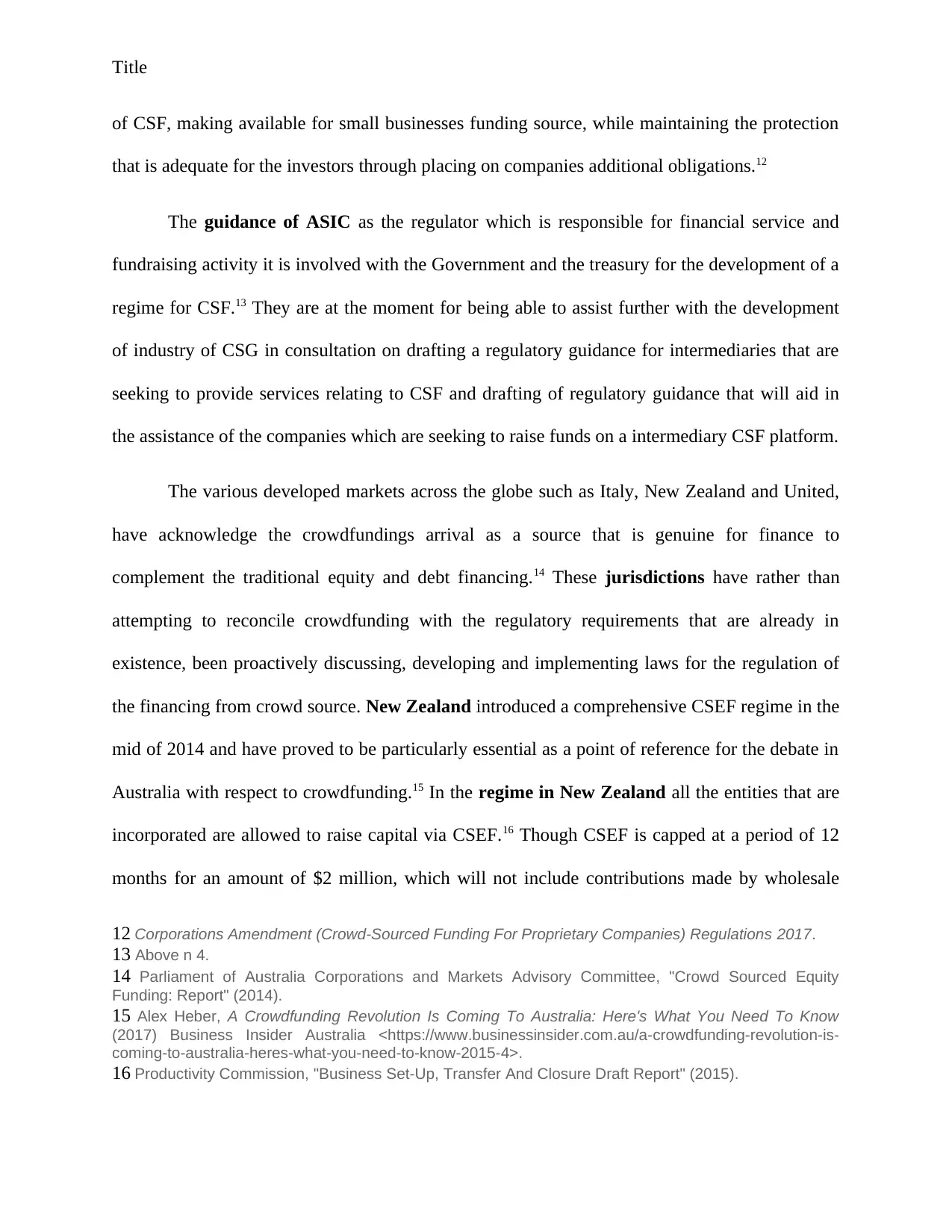
Title
of CSF, making available for small businesses funding source, while maintaining the protection
that is adequate for the investors through placing on companies additional obligations.12
The guidance of ASIC as the regulator which is responsible for financial service and
fundraising activity it is involved with the Government and the treasury for the development of a
regime for CSF.13 They are at the moment for being able to assist further with the development
of industry of CSG in consultation on drafting a regulatory guidance for intermediaries that are
seeking to provide services relating to CSF and drafting of regulatory guidance that will aid in
the assistance of the companies which are seeking to raise funds on a intermediary CSF platform.
The various developed markets across the globe such as Italy, New Zealand and United,
have acknowledge the crowdfundings arrival as a source that is genuine for finance to
complement the traditional equity and debt financing.14 These jurisdictions have rather than
attempting to reconcile crowdfunding with the regulatory requirements that are already in
existence, been proactively discussing, developing and implementing laws for the regulation of
the financing from crowd source. New Zealand introduced a comprehensive CSEF regime in the
mid of 2014 and have proved to be particularly essential as a point of reference for the debate in
Australia with respect to crowdfunding.15 In the regime in New Zealand all the entities that are
incorporated are allowed to raise capital via CSEF.16 Though CSEF is capped at a period of 12
months for an amount of $2 million, which will not include contributions made by wholesale
12 Corporations Amendment (Crowd-Sourced Funding For Proprietary Companies) Regulations 2017.
13 Above n 4.
14 Parliament of Australia Corporations and Markets Advisory Committee, "Crowd Sourced Equity
Funding: Report" (2014).
15 Alex Heber, A Crowdfunding Revolution Is Coming To Australia: Here's What You Need To Know
(2017) Business Insider Australia <https://www.businessinsider.com.au/a-crowdfunding-revolution-is-
coming-to-australia-heres-what-you-need-to-know-2015-4>.
16 Productivity Commission, "Business Set-Up, Transfer And Closure Draft Report" (2015).
of CSF, making available for small businesses funding source, while maintaining the protection
that is adequate for the investors through placing on companies additional obligations.12
The guidance of ASIC as the regulator which is responsible for financial service and
fundraising activity it is involved with the Government and the treasury for the development of a
regime for CSF.13 They are at the moment for being able to assist further with the development
of industry of CSG in consultation on drafting a regulatory guidance for intermediaries that are
seeking to provide services relating to CSF and drafting of regulatory guidance that will aid in
the assistance of the companies which are seeking to raise funds on a intermediary CSF platform.
The various developed markets across the globe such as Italy, New Zealand and United,
have acknowledge the crowdfundings arrival as a source that is genuine for finance to
complement the traditional equity and debt financing.14 These jurisdictions have rather than
attempting to reconcile crowdfunding with the regulatory requirements that are already in
existence, been proactively discussing, developing and implementing laws for the regulation of
the financing from crowd source. New Zealand introduced a comprehensive CSEF regime in the
mid of 2014 and have proved to be particularly essential as a point of reference for the debate in
Australia with respect to crowdfunding.15 In the regime in New Zealand all the entities that are
incorporated are allowed to raise capital via CSEF.16 Though CSEF is capped at a period of 12
months for an amount of $2 million, which will not include contributions made by wholesale
12 Corporations Amendment (Crowd-Sourced Funding For Proprietary Companies) Regulations 2017.
13 Above n 4.
14 Parliament of Australia Corporations and Markets Advisory Committee, "Crowd Sourced Equity
Funding: Report" (2014).
15 Alex Heber, A Crowdfunding Revolution Is Coming To Australia: Here's What You Need To Know
(2017) Business Insider Australia <https://www.businessinsider.com.au/a-crowdfunding-revolution-is-
coming-to-australia-heres-what-you-need-to-know-2015-4>.
16 Productivity Commission, "Business Set-Up, Transfer And Closure Draft Report" (2015).
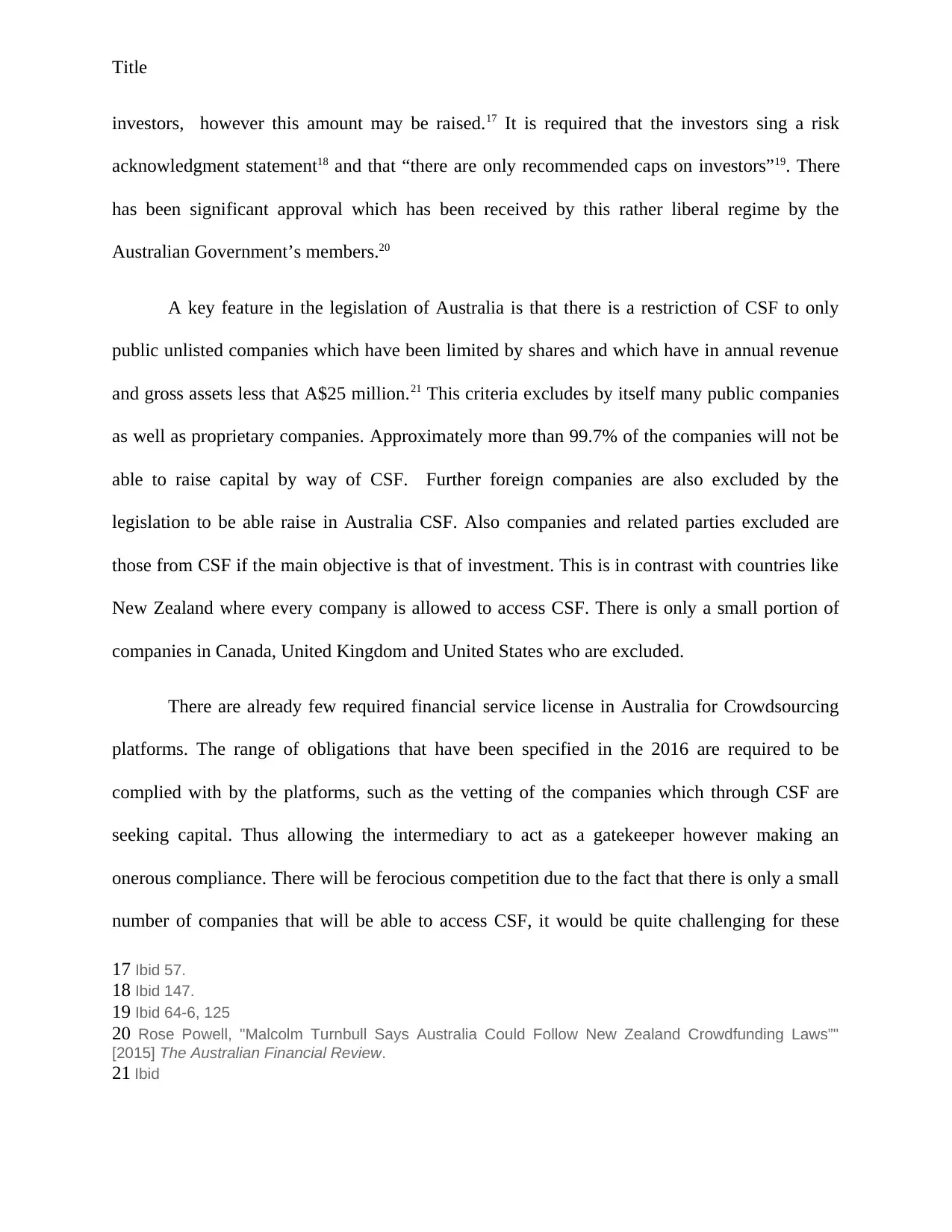
Title
investors, however this amount may be raised.17 It is required that the investors sing a risk
acknowledgment statement18 and that “there are only recommended caps on investors”19. There
has been significant approval which has been received by this rather liberal regime by the
Australian Government’s members.20
A key feature in the legislation of Australia is that there is a restriction of CSF to only
public unlisted companies which have been limited by shares and which have in annual revenue
and gross assets less that A$25 million.21 This criteria excludes by itself many public companies
as well as proprietary companies. Approximately more than 99.7% of the companies will not be
able to raise capital by way of CSF. Further foreign companies are also excluded by the
legislation to be able raise in Australia CSF. Also companies and related parties excluded are
those from CSF if the main objective is that of investment. This is in contrast with countries like
New Zealand where every company is allowed to access CSF. There is only a small portion of
companies in Canada, United Kingdom and United States who are excluded.
There are already few required financial service license in Australia for Crowdsourcing
platforms. The range of obligations that have been specified in the 2016 are required to be
complied with by the platforms, such as the vetting of the companies which through CSF are
seeking capital. Thus allowing the intermediary to act as a gatekeeper however making an
onerous compliance. There will be ferocious competition due to the fact that there is only a small
number of companies that will be able to access CSF, it would be quite challenging for these
17 Ibid 57.
18 Ibid 147.
19 Ibid 64-6, 125
20 Rose Powell, "Malcolm Turnbull Says Australia Could Follow New Zealand Crowdfunding Laws”"
[2015] The Australian Financial Review.
21 Ibid
investors, however this amount may be raised.17 It is required that the investors sing a risk
acknowledgment statement18 and that “there are only recommended caps on investors”19. There
has been significant approval which has been received by this rather liberal regime by the
Australian Government’s members.20
A key feature in the legislation of Australia is that there is a restriction of CSF to only
public unlisted companies which have been limited by shares and which have in annual revenue
and gross assets less that A$25 million.21 This criteria excludes by itself many public companies
as well as proprietary companies. Approximately more than 99.7% of the companies will not be
able to raise capital by way of CSF. Further foreign companies are also excluded by the
legislation to be able raise in Australia CSF. Also companies and related parties excluded are
those from CSF if the main objective is that of investment. This is in contrast with countries like
New Zealand where every company is allowed to access CSF. There is only a small portion of
companies in Canada, United Kingdom and United States who are excluded.
There are already few required financial service license in Australia for Crowdsourcing
platforms. The range of obligations that have been specified in the 2016 are required to be
complied with by the platforms, such as the vetting of the companies which through CSF are
seeking capital. Thus allowing the intermediary to act as a gatekeeper however making an
onerous compliance. There will be ferocious competition due to the fact that there is only a small
number of companies that will be able to access CSF, it would be quite challenging for these
17 Ibid 57.
18 Ibid 147.
19 Ibid 64-6, 125
20 Rose Powell, "Malcolm Turnbull Says Australia Could Follow New Zealand Crowdfunding Laws”"
[2015] The Australian Financial Review.
21 Ibid
⊘ This is a preview!⊘
Do you want full access?
Subscribe today to unlock all pages.

Trusted by 1+ million students worldwide
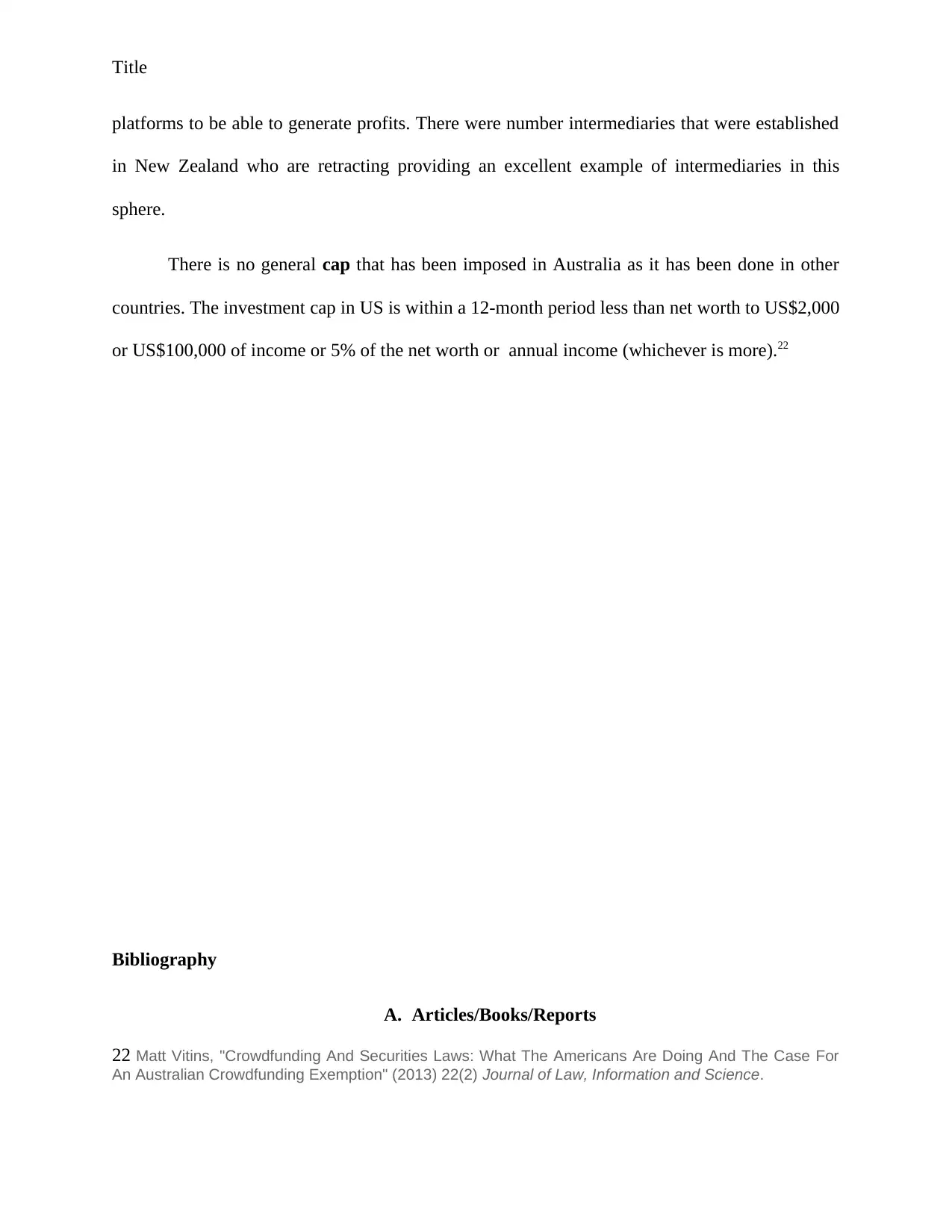
Title
platforms to be able to generate profits. There were number intermediaries that were established
in New Zealand who are retracting providing an excellent example of intermediaries in this
sphere.
There is no general cap that has been imposed in Australia as it has been done in other
countries. The investment cap in US is within a 12-month period less than net worth to US$2,000
or US$100,000 of income or 5% of the net worth or annual income (whichever is more).22
Bibliography
A. Articles/Books/Reports
22 Matt Vitins, "Crowdfunding And Securities Laws: What The Americans Are Doing And The Case For
An Australian Crowdfunding Exemption" (2013) 22(2) Journal of Law, Information and Science.
platforms to be able to generate profits. There were number intermediaries that were established
in New Zealand who are retracting providing an excellent example of intermediaries in this
sphere.
There is no general cap that has been imposed in Australia as it has been done in other
countries. The investment cap in US is within a 12-month period less than net worth to US$2,000
or US$100,000 of income or 5% of the net worth or annual income (whichever is more).22
Bibliography
A. Articles/Books/Reports
22 Matt Vitins, "Crowdfunding And Securities Laws: What The Americans Are Doing And The Case For
An Australian Crowdfunding Exemption" (2013) 22(2) Journal of Law, Information and Science.
Paraphrase This Document
Need a fresh take? Get an instant paraphrase of this document with our AI Paraphraser
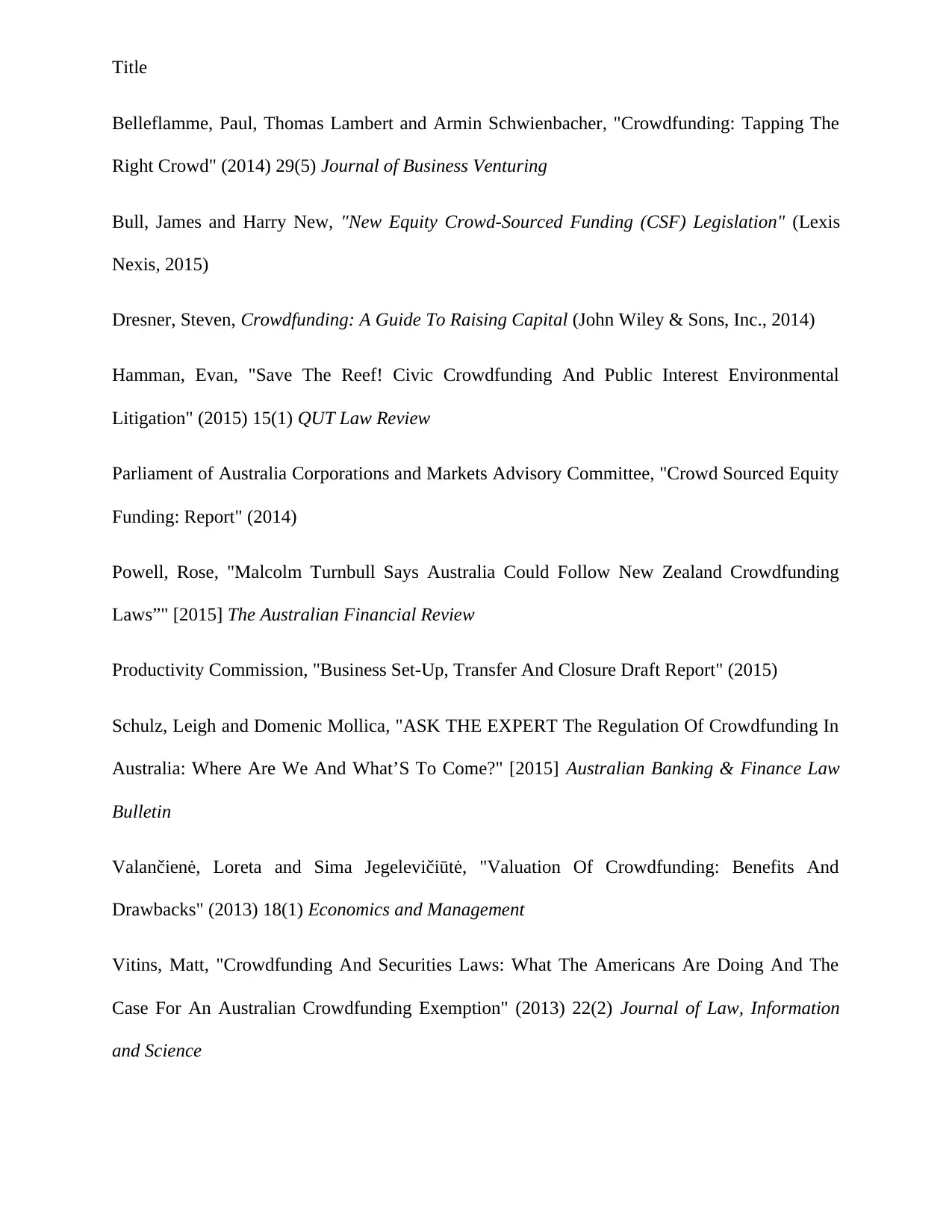
Title
Belleflamme, Paul, Thomas Lambert and Armin Schwienbacher, "Crowdfunding: Tapping The
Right Crowd" (2014) 29(5) Journal of Business Venturing
Bull, James and Harry New, "New Equity Crowd-Sourced Funding (CSF) Legislation" (Lexis
Nexis, 2015)
Dresner, Steven, Crowdfunding: A Guide To Raising Capital (John Wiley & Sons, Inc., 2014)
Hamman, Evan, "Save The Reef! Civic Crowdfunding And Public Interest Environmental
Litigation" (2015) 15(1) QUT Law Review
Parliament of Australia Corporations and Markets Advisory Committee, "Crowd Sourced Equity
Funding: Report" (2014)
Powell, Rose, "Malcolm Turnbull Says Australia Could Follow New Zealand Crowdfunding
Laws”" [2015] The Australian Financial Review
Productivity Commission, "Business Set-Up, Transfer And Closure Draft Report" (2015)
Schulz, Leigh and Domenic Mollica, "ASK THE EXPERT The Regulation Of Crowdfunding In
Australia: Where Are We And What’S To Come?" [2015] Australian Banking & Finance Law
Bulletin
Valančienė, Loreta and Sima Jegelevičiūtė, "Valuation Of Crowdfunding: Benefits And
Drawbacks" (2013) 18(1) Economics and Management
Vitins, Matt, "Crowdfunding And Securities Laws: What The Americans Are Doing And The
Case For An Australian Crowdfunding Exemption" (2013) 22(2) Journal of Law, Information
and Science
Belleflamme, Paul, Thomas Lambert and Armin Schwienbacher, "Crowdfunding: Tapping The
Right Crowd" (2014) 29(5) Journal of Business Venturing
Bull, James and Harry New, "New Equity Crowd-Sourced Funding (CSF) Legislation" (Lexis
Nexis, 2015)
Dresner, Steven, Crowdfunding: A Guide To Raising Capital (John Wiley & Sons, Inc., 2014)
Hamman, Evan, "Save The Reef! Civic Crowdfunding And Public Interest Environmental
Litigation" (2015) 15(1) QUT Law Review
Parliament of Australia Corporations and Markets Advisory Committee, "Crowd Sourced Equity
Funding: Report" (2014)
Powell, Rose, "Malcolm Turnbull Says Australia Could Follow New Zealand Crowdfunding
Laws”" [2015] The Australian Financial Review
Productivity Commission, "Business Set-Up, Transfer And Closure Draft Report" (2015)
Schulz, Leigh and Domenic Mollica, "ASK THE EXPERT The Regulation Of Crowdfunding In
Australia: Where Are We And What’S To Come?" [2015] Australian Banking & Finance Law
Bulletin
Valančienė, Loreta and Sima Jegelevičiūtė, "Valuation Of Crowdfunding: Benefits And
Drawbacks" (2013) 18(1) Economics and Management
Vitins, Matt, "Crowdfunding And Securities Laws: What The Americans Are Doing And The
Case For An Australian Crowdfunding Exemption" (2013) 22(2) Journal of Law, Information
and Science
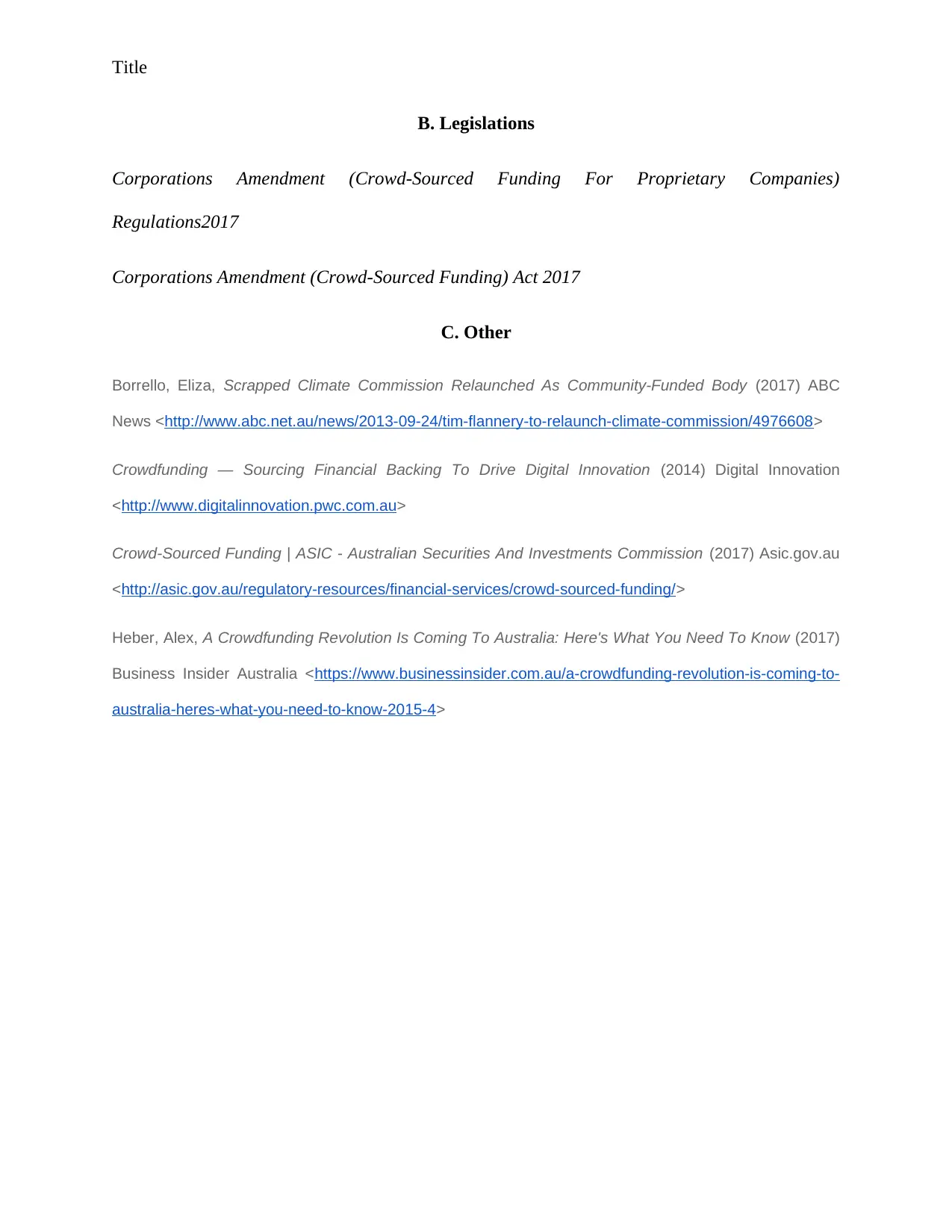
Title
B. Legislations
Corporations Amendment (Crowd-Sourced Funding For Proprietary Companies)
Regulations2017
Corporations Amendment (Crowd-Sourced Funding) Act 2017
C. Other
Borrello, Eliza, Scrapped Climate Commission Relaunched As Community-Funded Body (2017) ABC
News <http://www.abc.net.au/news/2013-09-24/tim-flannery-to-relaunch-climate-commission/4976608>
Crowdfunding — Sourcing Financial Backing To Drive Digital Innovation (2014) Digital Innovation
<http://www.digitalinnovation.pwc.com.au>
Crowd-Sourced Funding | ASIC - Australian Securities And Investments Commission (2017) Asic.gov.au
<http://asic.gov.au/regulatory-resources/financial-services/crowd-sourced-funding/>
Heber, Alex, A Crowdfunding Revolution Is Coming To Australia: Here's What You Need To Know (2017)
Business Insider Australia <https://www.businessinsider.com.au/a-crowdfunding-revolution-is-coming-to-
australia-heres-what-you-need-to-know-2015-4>
B. Legislations
Corporations Amendment (Crowd-Sourced Funding For Proprietary Companies)
Regulations2017
Corporations Amendment (Crowd-Sourced Funding) Act 2017
C. Other
Borrello, Eliza, Scrapped Climate Commission Relaunched As Community-Funded Body (2017) ABC
News <http://www.abc.net.au/news/2013-09-24/tim-flannery-to-relaunch-climate-commission/4976608>
Crowdfunding — Sourcing Financial Backing To Drive Digital Innovation (2014) Digital Innovation
<http://www.digitalinnovation.pwc.com.au>
Crowd-Sourced Funding | ASIC - Australian Securities And Investments Commission (2017) Asic.gov.au
<http://asic.gov.au/regulatory-resources/financial-services/crowd-sourced-funding/>
Heber, Alex, A Crowdfunding Revolution Is Coming To Australia: Here's What You Need To Know (2017)
Business Insider Australia <https://www.businessinsider.com.au/a-crowdfunding-revolution-is-coming-to-
australia-heres-what-you-need-to-know-2015-4>
⊘ This is a preview!⊘
Do you want full access?
Subscribe today to unlock all pages.

Trusted by 1+ million students worldwide
1 out of 12
Related Documents
Your All-in-One AI-Powered Toolkit for Academic Success.
+13062052269
info@desklib.com
Available 24*7 on WhatsApp / Email
![[object Object]](/_next/static/media/star-bottom.7253800d.svg)
Unlock your academic potential
Copyright © 2020–2025 A2Z Services. All Rights Reserved. Developed and managed by ZUCOL.





